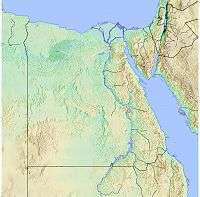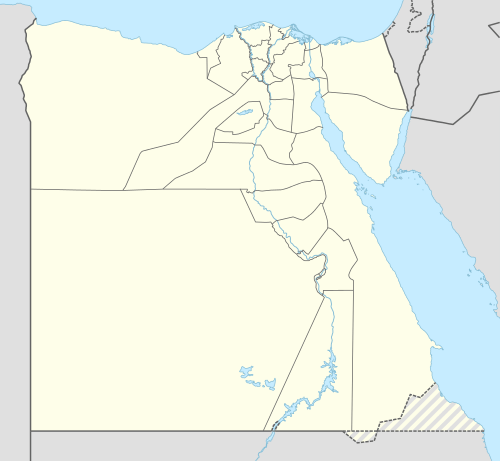Land of Goshen
The Land of Goshen (Hebrew: אֶרֶץ גֹּשֶׁן or ארץ גושן Eretz Gošen) is named in the Bible as the place in Egypt given to the Hebrews by the pharaoh of Joseph (Genesis 45:9 - 10), and the land from which they later left Egypt at the time of the Exodus. It was located in the eastern Delta of the Nile.
Meaning of the name
If the Septuagint reading "Gesem" is correct, the word, which in its Hebrew form has no known meaning, may mean "cultivated"—comparing the Arabic root j-š-m, "to labor." Egyptologists have suggested a connection with the Egyptian word qas, meaning "inundated land" because Goshen was apparently the same region, called by the Greeks the "Arabian nome," which had its capital at Phakousa representing the Egyptian Pa-qas (Brugsch, Geog., I, 298), the name of a town, with the determinative for "pouring forth".[1] Donald Redford, while not disputing the location of Goshen, gives a different origin for the name, deriving it from "Gasmu," the rulers of the Bedouin Qedarites who occupied the eastern Delta from the 7th century BC, but John Van Seters thinks this unlikely.[2]
Though many have searched for an Egyptian meaning to Goshen, it seems that there is only meaning through Hebrew, as if it were a word meaningful only to the Hebrews who settled there. The ancient rabbis who divided the Torah into weekly portions emphasized that they saw the name Goshen as connected to the verb NaGaSh (נִגַּשׁ), to approach. The Torah portion (Genesis 44:18—47:27) in which Goshen is first mentioned is known by its first Hebrew word, vaYi(n)gash, וַיִּגַּשׁ , "Then Judah approached (Joseph)..." Just a few verses later (45:10) Goshen is mentioned, for the first time in the Bible, when Joseph sends word to Jacob, saying "...live in the land of Goshen, and you will be near me." It is as if to say, "you'll live in the approaches to Egypt, not all the way in, so that when it is time to leave, you'll be able to leave quickly." The last verse of this portion is, (47:27) "Thus Israel settled in the land of Egypt, in the land of Goshen."
Goshen in Egypt

According to the Joseph narrative in the Book of Genesis, the sons of Jacob (Israel) who were living in Hebron, experienced a severe famine that lasted seven years. Since word was that Egypt was the only kingdom able to supply food, the sons of Jacob (Israel) journeyed there to buy goods. In the second year of famine,[3] the Vizier of Egypt, Joseph,[4][5] invited the sons of Israel to live in Egyptian territory. They settled in the country of Goshen.[6] Goshen is described as the best land in Egypt, suitable for both crops and livestock. It has been suggested that this location may have been somewhat apart from Egypt, because Genesis 46:34 states, "Ye may dwell in the land of Goshen; for every shepherd is an abomination unto the Egyptians." After the death of Joseph and those of his generation, the following generations of Israelites had become populous in number. The Egyptians feared potential integration or takeover, so they enslaved the Israelites and took away their human rights.
Approximately four hundred and thirty years later,[7] Moses was called to lead the Israelites out of Egypt, from Goshen to Succoth,[8] the first waypoint of the Exodus. They pitched at 41 locations crossing the Nile Delta, to the last station being the plains of Moab.[9]
Identification

In 1885 E.H. Naville identified Goshen as the 20th nome of Egypt, located in the eastern Delta, and known as "Gesem" or "Kesem" during the Twenty-sixth dynasty of Egypt (672-525 BC). It covered the western end of the Wadi Tumilat, the eastern end being the district of Succoth (Sukkot (place)), which had Pithom as its main town, extended north as far as the ruins of Piramesse (the "land of Rameses"), and included both crop land and grazing land.[10]
References
- ↑ "www.Bibler.org - Dictionary - Goshen". 2012-10-08.
- ↑ Donald Redford, "Perspective on the Exodus", pp.139-140, quoted in John Van Seters, "The Geography of the Exodus," in Silberman, Neil Ash (editor), The Land That I Will Show You: Essays in History and Archaeology of the Ancient Near East in Honor of J. Maxwell Miller (Sheffield Academic Press, 1997) fn.37, p.269
- ↑ Genesis 45:11
- ↑ Mehler, S. From Light Into Darkness: The Evolution of Religion in Ancient Egypt, (ISBN 978-1-931882-49-1), 2005, p. 133
- ↑ Joseph may also have been Co-regent with the Pharaoh as indicated by Genesis 44:18 - Josephus. The Antiquities of the Jews, Book II, 7.1.168
- ↑ Genesis 46:34,47:27
- ↑ Ex.12:40-41, Gal. 3:17
- ↑ Numbers 33:5
- ↑ numbers 22:1,33:48-50
- ↑ John Van Seters, "The Geography of the Exodus," in Silberman, Neil Ash (editor), The Land That I Will Show You: Essays in History and Archaeology of the Ancient Near East in Honor of J. Maxwell Miller (Sheffield Academic Press, 1997) P. 267-269, ISBN 978-1850756507
External links
 Macalister, R. A. Stewart (1911). "Goshen, a division of Egypt settled by the Israelites between Jacob's immigration and the Exodus". Encyclopædia Britannica (11th ed.).
Macalister, R. A. Stewart (1911). "Goshen, a division of Egypt settled by the Israelites between Jacob's immigration and the Exodus". Encyclopædia Britannica (11th ed.).